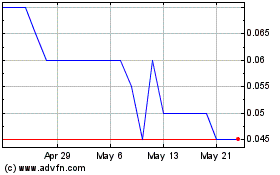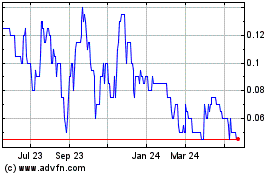Emgold Announces Idaho-Maryland Project Update
10 March 2011 - 12:30AM
Marketwired Canada
Emgold Mining Corporation (TSX VENTURE:EMR)(PINK SHEETS:EGMCF)(FRANKFURT:EML) -
Project Overview
Emgold Mining Corporation (Emgold or the Company) provides the following update
on its Idaho-Maryland Project (Project), located in Grass Valley, California.
The Idaho-Maryland Mine was once the second largest underground gold mine in
California and is reported to have produced 2.4 million ounces of gold at an
average recovered grade of 0.43 ounce per ton. The mine contains a NI 43-101
compliant measured and indicated resource of 472,000 ounces of gold at a grade
of 0.28 ounces per ton and an inferred resource of 1,002,000 ounces of gold at a
grade of 0.39 ounce per ton, estimated as of March 1, 2007 (see Emgold's NI
43-101 compliant Technical Report titled "Idaho-Maryland Mine Project" dated
December 8, 2009 at www.emgold.com or, filed under the Company's profile at
www.sedar.com). A detailed summary of the Idaho-Maryland Project is available at
www.emgold.com and www.idaho-maryland.com.
Permitting Status
Emgold is in the advanced stage of permitting the re-opening of the mine and is
completing an Environmental Impact Report (EIR) for the Project through its 100%
owned subsidiary, Idaho-Maryland Mining Corporation (IMMC). The preparation of
the EIR commenced in July 2007 in accordance with the California Environmental
Quality Act (CEQA). A Draft EIR was completed in October 2008 by the City of
Grass Valley (City), the CEQA lead agency, and its consultant Environmental
Science Associates (ESA) and the public comment period for the Draft EIR was
completed in January 2009. The Draft EIR indicated that of the 15 areas
evaluated, the Company was successfully able to avoid or mitigate potential
environmental impacts of the Project in all areas, but one. This is a major
accomplishment for any mining and/or industrial project, regardless of the
jurisdiction.
After reviewing the Draft EIR, meeting with various government agencies to
review their comments, reviewing public comments from the Draft EIR obtained
during the public comment period (letters and public meetings), and obtaining
input from the local community through IMMC's community outreach program, IMMC
elected in mid-2009 to clarify and amplify the project design contained in
Project Applications to further mitigate and/or eliminate potential
environmental impacts of the Project identified in the Draft EIR. As the air
quality analysis in that document identified certain impacts to be potentially
significant, the primary focus of this work was to lessen potential air quality
impacts from oxides of nitrogen, random organic gases, respirable dust (PM10),
and greenhouse gas emissions. The project description revisions in the Project
Applications reflect the goal of Emgold and IMMC to ensure the Idaho-Maryland
Mine Project is a socially and environmentally responsible project that will
benefit the City, Nevada County, the local communities, and our shareholders.
IMMC has completed significant work on air quality modeling for the Project and
alternatives to address the air quality impacts outlined in the Draft EIR.
Modeling done by IMMC's air quality experts has significantly reduced oxides of
nitrogen, reactive organic gases, and respirable particulate matter from
previous estimates contained in the Draft EIR. IMMC's proposed measures taken to
accomplish these reductions include, but are not limited to, use of a Traffic
Management Plan (e.g., van-pooling and car-pooling) to reduce employee traffic
trips and associated air emissions, use of low NOX burners for combustion of
natural gas, use of emulsion explosives, use of higher tier engines for off road
underground and surface equipment, and use of shaft hoisting instead of trucking
for material handling of ore and development rock.
IMMC expects to submit revised Project Application documents to the City in
April, 2011. Based on CEQA guidelines, after review of the project design
modifications reflected in the Application documents, the City may determine
that a Revised Draft EIR is required for the project and circulate it for public
comment. Alternatively, the City may elect to proceed with preparation of the
Final EIR. IMMC anticipates a Revised Draft EIR will be required and has been
proceeding on this basis since mid-2009.
The Final EIR will be prepared by the City and its consultant. The Grass Valley
Planning Commission will review the Final EIR and entitlements for the Project,
make a determination if the documents are complete and adequate, and forward the
package to the Grass Valley City Council. The City Council will be responsible
for Certification of the Final EIR, approving the entitlements, and approving a
Conditional Use Permit for the Project. It is anticipated that the Final EIR can
be completed in 2011.
David Watkinson, President and CEO of Emgold stated, "Emgold is busy on a number
of fronts with the Idaho-Maryland Project and our other exploration properties
located in Nevada and British Columbia. Our main focus is the Idaho-Maryland
Project, and we have made a number of improvements and ensured that input from
the public is incorporated into the project changes. We are excited to start
moving forward again in the public domain with the Idaho-Maryland Project in
anticipation of completing the California Environmental Quality Act (CEQA)
process to allow us to advance the development of the Idaho-Maryland Mine."
In addition, Watkinson also stated, "The Idaho-Maryland Project is expected to
result in 400 permanent jobs the Grass Valley and Nevada County area. The
unemployment rate for Nevada County currently stands at 11.2% (January 21, 2011
California EDD Report, Preliminary numbers for December, 2010). The Grass Valley
Mining District was once a major gold mining district in the U.S., and the mines
within a three mile radius of the Idaho-Maryland Project are reported to have
produced over 13 million ounces of gold between roughly 1850 and 1956. The mines
shut down in 1956 due to the fixed price of gold by the U.S. government at
US$35.00 per ounce and rising labor and supply costs after WWII. Emgold
management believes the Idaho-Maryland Project is a world class gold deposit,
and its development will positively impact the local and state economies."
The Gold Mining Industry in California
The years 2007 and 2009 saw the reopening of New Gold Inc.'s Mesquite Mine and
ATNA's Briggs Mine respectively, both located in California. Gold production in
California, which had decreased from 553,000 ounces per year in 2000, has now
rebounded from a low of 19,400 ounces per year in 2007 to 161,400 ounces per
year in 2009 (See Table 1). Other advanced stage gold projects in the permitting
process in California include Sutter Gold Mining Corporation's Lincoln Project
and Golden Queen Mining Company's Soledad Mountain Project.
Table 1
Recent Gold Production in California Years 2000 to 2009
----------------------------------------------------------------------------
Year Ounces of Gold Produced
----------------------------------------------------------------------------
2000 553,000
----------------------------------------------------------------------------
2001 452,500
----------------------------------------------------------------------------
2002 306,300
----------------------------------------------------------------------------
2003 141,000
----------------------------------------------------------------------------
2004 95,700
----------------------------------------------------------------------------
2005 65,300
----------------------------------------------------------------------------
2006 21,600
----------------------------------------------------------------------------
2007 19,400
----------------------------------------------------------------------------
2008 119,300
----------------------------------------------------------------------------
2009 161,400
----------------------------------------------------------------------------
Sources: State of California Non-Fuel Mineral Production Reports, 2001 to
2008.
Northwest Mining Association, Gold Production by State, Updated
Aug 2010.
Watkinson stated, "As outlined in recent articles in the New York Times and
Washington Post referencing the Idaho-Maryland Project, the idea of a California
Gold Rush is a thing of the past, despite the current high gold price per ounce.
The average time to permit a mine anywhere in the U.S., including Nevada is
currently in excess of 7 years. Despite this, we should see a steady increase in
gold production in California over the next few years as a variety of projects
work their way through the permitting process. With an unemployment rate of
12.5% in California (Source: U.S. Department of Labor Statistic, Preliminary
Numbers, December 2010), the gold mining industry in California could achieve a
500,000 ounce per year production rate again within the next decade. This would
represent about US$700 million input per year for the California economy at the
current gold price of about US$1,400 per ounce. In 2008, California's non-fuel
mineral production, which includes gold, was US$4.0 billion. This included 717
active mines and directly employed about 10,000 people at the mines and their
processing plants (Source, California Non-Fuel Production, 2008, USGS).
According to the United States Bureau of Economic Analysis, California's Gross
Domestic Product ("GDP") for mining in 2009 was $15 billion while Nevada's GDP
for mining in 2009 was only $4.3 billion. We believe that California is a good
place to develop a gold mine and do profitable and responsible business."
Information in this news release that is of a scientific or technical nature was
prepared by Mr. Robert Pease, Professional Geologist (California), Chief
Geologist of the Company. For more information about Emgold, the Idaho-Maryland
Gold Project and the Buckskin Rawhide, Stewart, and Rozan Properties, please
visit www.emgold.com.
On behalf of the Board of Directors
David G. Watkinson, P.Eng., President & CEO
This news release may include certain statements that may be deemed
"forward-looking statements". All statements in this release, other than
statements of historical facts, that address the mineral resource estimates, are
forward-looking statements and are based on a number of assumptions, including
but not limited to the assumptions underlying the estimated resources outlined
in the Technical Report are and remain valid, that the demand for and price of
gold remains constant or increases and does not experience a material decline,
and that the Company will be able to raise the capital required to hold and
develop the Idaho-Maryland Project. Although the Company believes the
expectations expressed in such forward-looking statements are based on
reasonable assumptions, such statements are not guarantees of future performance
and actual results or developments may differ materially from those in the
forward-looking statements. Factors that could cause actual results to differ
materially from those in forward-looking statements include changes the price of
gold, the price of the company's shares, the costs of labour, equipment and
other costs associated with exploration, development and mining operations,
exploitation and exploration successes, continued availability of capital and
financing, and general economic, market or business conditions. Investors are
cautioned that any such statements are not guarantees of future performance and
actual results or developments may differ materially from those projected in the
forward-looking statements. For more information on the Company, Investors
should review the Company's filings that are available at www.sedar.com or the
Company's website at www.emgold.com.
U.S. 20-F Registration: 000-51411
Emergent Metals (TSXV:EMR)
Historical Stock Chart
From Jan 2025 to Feb 2025

Emergent Metals (TSXV:EMR)
Historical Stock Chart
From Feb 2024 to Feb 2025
